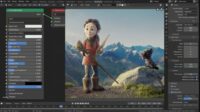
Exploring the World of 3D Modeling Software: An Overview
Introduction
Three-dimensional (3D) modeling software has revolutionized the way we design, visualize, and create in various industries. From architecture to engineering, product design, entertainment, and even medicine, 3D modeling has become an essential tool for professionals and hobbyists alike.
This article aims to provide a comprehensive overview of the world of 3D modeling software, exploring its different types, key features, and applications. We will also discuss the factors to consider when choosing a 3D modeling software and provide an FAQ and reference section for further information.
Types of 3D Modeling Software
3D modeling software can be broadly classified into two main types:
- Polygonal Modeling: This type of modeling creates 3D objects using polygonal meshes, which are composed of vertices, edges, and faces. Polygonal modeling is ideal for creating complex organic shapes and is widely used in animation, gaming, and product design.
- NURBS (Non-Uniform Rational Basis Spline) Modeling: This type of modeling uses mathematical equations to define smooth, curved surfaces. NURBS models are often preferred for industrial design, architecture, and automotive design, where precision and accuracy are crucial.
Key Features of 3D Modeling Software
Modern 3D modeling software offers a wide range of features that cater to different needs and workflows. Some of the key features include:
- Modeling Tools: These tools enable you to create, edit, and manipulate 3D objects using various techniques such as extrusion, sculpting, and Boolean operations.
- Texturing Tools: These tools allow you to apply textures, materials, and colors to your models to enhance their realism and visual appeal.
- Animation Tools: These tools let you create animations by defining keyframes and interpolating the movement of objects over time.
- Rendering Tools: These tools generate high-quality images and videos of your 3D models, enabling you to present and visualize your designs in a realistic manner.
- Simulation Tools: These tools allow you to simulate the physical properties of your 3D models, such as dynamics, fluids, and collisions.
Applications of 3D Modeling Software
3D modeling software finds applications in numerous fields, including:
- Architecture and Engineering: Creating architectural designs, building models, and infrastructure simulations.
- Product Design: Developing product concepts, visualizing prototypes, and generating technical drawings.
- Entertainment: Creating characters, environments, and props for movies, games, and animation.
- Medical: Visualizing anatomical structures, planning surgeries, and designing medical devices.
- Education: Teaching students about 3D design, modeling, and visualization.
Choosing a 3D Modeling Software
Choosing the right 3D modeling software depends on several factors, including:
- Industry and Purpose: The type of work you will be doing and the industry you are in will influence the features you need.
- Skill Level: Some software is designed for beginners, while others require advanced skills and knowledge.
- Budget: 3D modeling software can range from free and open-source options to professional-grade software with licensing fees.
- Hardware Requirements: The software you choose should be compatible with your computer’s hardware, especially in terms of graphics processing power and memory.
FAQ
Q: What is the best 3D modeling software for beginners?
A: Blender, SketchUp, and Tinkercad are popular free and beginner-friendly options.
Q: How long does it take to learn 3D modeling?
A: The learning curve varies depending on the software and the desired skill level. Basic 3D modeling concepts can be grasped in a few weeks, but mastering advanced techniques may take months or even years.
Q: Is 3D modeling hard to learn?
A: While 3D modeling requires some spatial reasoning and technical understanding, it is not inherently difficult to learn. With practice and patience, anyone can become proficient in 3D modeling.
Q: What are the job opportunities for 3D modelers?
A: 3D modelers are in high demand in various industries, including entertainment, product design, architecture, and engineering.
Reference


